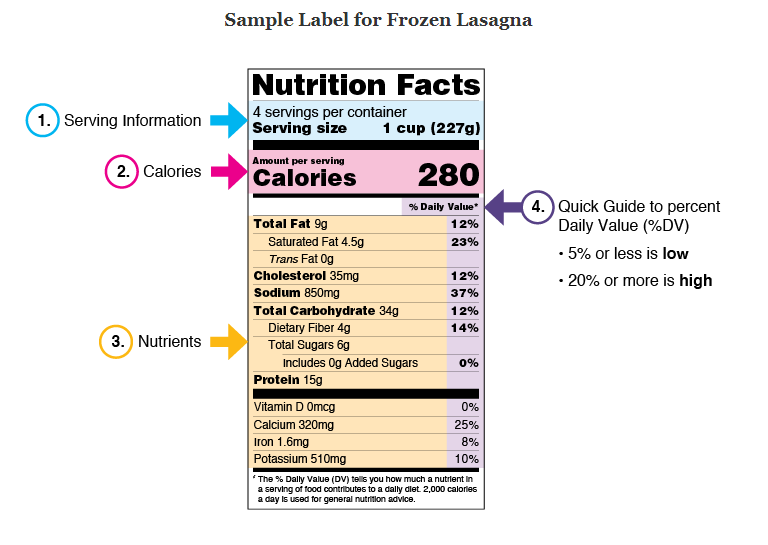How To Read Food Labels Guide
- By LabelValue Team
- Jan 23, 2024
How to read food labels for healthy eating is becoming a popular trend.
All food labels must also have an ingredient label, also known as a nutritional label.
There are currently 15 different types of nutrition fact labels. We will review how to best read them today.
Reading food labels is an essential skill for making informed and healthy food choices. To also live a healthy lifestyle. Keep reading our food labels guide to learn how to read labels on food.
Here's tips on how to interpret food labels:
-
Serving Size: #1 on the food label diagram. The serving size is not a recommended amount to eat or drink. Start by looking at the serving size. All the information on the label is based on this serving size. The serving size is one of the most important numbers on the food label. Make sure to adjust the values if you plan to eat more or less than the specified serving.
-
Calories: #2 on the ingredient labels diagram. How to read calories on food labels? Check the calorie content per serving. The calories are a measure of how much energy the food or drink will give you. This information tells you how much energy you'll get from consuming one serving of the product.
-
Nutrient Content: #3 on the ingredient label diagram. Look at the amounts of macronutrients (proteins, fats, and carbohydrates) and micronutrients (vitamins and minerals) in the product. Pay attention to the percentage of daily values (%DV) provided. Generally, 5% DV or less is considered low, and 20% DV or more is high. Nutrients to get more of are dietary fiber, vitamin D, calcium, Iron, and Potassium. Nutrients to get less of are saturated fat, sodium, and added sugars.
-
Total Fat: Be aware of the total fat content and the types of fat (saturated, trans, and unsaturated). Aim for products low in saturated and trans fats. A recent study from the Dietary Guidelines for Americans found that Trans fats are associated with an increased blood level of Low-density lipoprotein, known as LDL, which results in an increased risk of cardiovascular disease. Most Trans fats have been removed from American foods in 2018.
-
Cholesterol and Sodium: How to read food labels for cholesterol? Limit intake of cholesterol and sodium. High intake of these can contribute to heart problems. So look for minimal cholesterol and sodium number levels.
-
Total Carbohydrates: Check the total carbohydrates and dietary fiber. Fiber is beneficial for digestion, and a diet high in fiber can be helpful for overall health.
-
Protein: Ensure an adequate protein intake, especially if you are physically active or trying to build muscle.
-
-
Sugar Content: How to read added sugar in food labels? Pay attention to the total sugar content. Natural sugars, like those in fruits, are generally healthier than added sugars. Avoid and Be aware of different names for added sugars, such as sucrose, glucose, high-fructose corn syrup, etc.
-
Ingredients List: Ingredient labels are listed in descending order by weight. Ingredient labels are required on all food labels.
Be cautious of products with a long list of ingredients, especially if you don't recognize some of them. If the ingredient list label is full of chemicals and additives, you will want to find another food or beverage to buy. -
Allergens: How to read a food label for allergens? Check for allergen information. Common allergens like nuts, soy, dairy, and gluten should be clearly labeled. You can also check the ingredients list on the nutrition facts panel to see if the food allergen you have is listed there.
-
Daily Values (DV): #4 on the diagram above. The %DV helps you see how much a nutrient in a serving of food contributes to a daily diet. It's based on a daily intake of 2,000 calories, so your needs may vary. Use it as a general guide.
-
Claims and Labels: Be cautious of terms like "low-fat," "reduced sodium," or "high-fiber." Sometimes, these claims can be misleading. Always check the actual values on the nutrition label.
-
Expiration Date: Check the expiration or "use by" date to ensure the product is fresh and safe to consume.
-
Compare Products: When choosing between similar products, compare their nutritional content. Choose the option that aligns with your dietary goals.
Do you need food labels for your products?

 Save 10% off your first LabelValue order |
Save 10% off your first LabelValue order | 